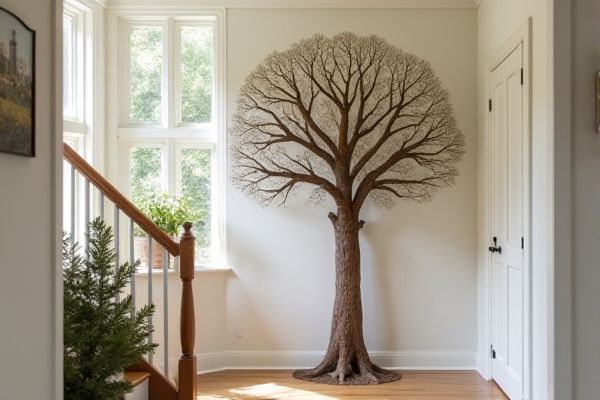
Choosing between an entryway tree and a wall peg rail depends on your space and storage needs; entryway trees offer a more sculptural, freestanding option for hanging coats and hats, while wall peg rails provide a streamlined, space-saving solution that integrates seamlessly with your wall. Discover which option best suits Your entryway by exploring the detailed benefits and design tips ahead.
Table of Comparison
| Feature | Entryway Tree | Wall Peg Rail |
|---|---|---|
| Design | Free-standing, sculptural piece | Mounted horizontal rail with multiple pegs |
| Installation | No installation required, portable | Requires wall mounting with screws or anchors |
| Space Utilization | Consumes floor space | Saves floor space, uses wall area |
| Capacity | Multiple hooks for coats, hats, bags | Varies by peg count; usually fewer hooks |
| Style Options | Varied artistic and rustic styles | Sleek, minimalist, or traditional styles |
| Durability | Typically sturdy, solid wood or metal | Depends on material; wood or metal rails common |
| Price Range | $50 - $200+ | $20 - $100+ |
| Best Use Case | Entryways with floor space; statement piece | Small or narrow spaces; maximizing wall storage |
Introduction to Entryway Organization Solutions
Entryway trees and wall peg rails provide versatile entryway organization solutions designed to maximize space and functionality. Entryway trees offer vertical storage with multiple hooks for coats, hats, and bags, making them ideal for compact areas needing centralized organization. Wall peg rails, mounted on walls, create customizable hanging options and frequently include additional shelves or compartments, enhancing both storage capacity and aesthetic appeal.
What Is an Entryway Tree?
An entryway tree is a freestanding coat rack designed to hold hats, coats, scarves, and bags, featuring multiple hooks branching out like tree limbs. Unlike a wall peg rail, which mounts directly to the wall and offers a linear arrangement of hooks, an entryway tree provides a more versatile and decorative storage solution in your foyer or hallway. Its vertical structure allows easy access and organization without requiring wall installation.
What Is a Wall Peg Rail?
A wall peg rail is a versatile storage solution consisting of evenly spaced pegs mounted on a wooden or metal rail, ideal for hanging coats, bags, and accessories in an entryway. Unlike an entryway tree, which is a freestanding unit often bulkier and occupying floor space, a wall peg rail maximizes vertical space and keeps your entryway organized without clutter. Your choice depends on available space and aesthetic preference, but the wall peg rail offers a sleek, minimalist option for efficient storage.
Space Requirements: Entryway Tree vs Wall Peg Rail
An entryway tree typically requires more floor space due to its standalone structure and multiple hooks branching out at different heights. Wall peg rails maximize vertical wall space and are ideal for narrow entryways where floor space is limited. Choosing between the two depends on available room, with peg rails offering a space-efficient solution and entryway trees providing a decorative, multi-functional option.
Aesthetic Appeal and Design Options
Entryway trees offer a sculptural and organic appeal with multiple branches for hanging coats and accessories, enhancing the natural ambiance of the space. Wall peg rails present a minimalist and streamlined design, available in various materials and finishes that complement modern, rustic, or industrial interiors. Both options provide versatile placement and customization but differ in visual impact--entryway trees create a freestanding focal point, while wall peg rails maintain a subtle, integrated aesthetic.
Storage Capacity and Versatility
Entryway trees offer higher storage capacity with multiple branches for hanging coats, hats, and bags, making them ideal for larger households or frequent guests. Wall peg rails provide more versatility in tight spaces by allowing customized arrangements of hooks and shelves, fitting varied item sizes and styles. You can maximize entryway organization by choosing the option that best suits your available space and storage needs.
Installation and Maintenance Considerations
Entryway trees typically require floor space and may involve simple assembly with screws or bolts, while wall peg rails demand secure wall anchoring, often needing studs for stability. Maintenance for entryway trees involves regular dusting and occasional tightening of joints, whereas wall peg rails are generally easier to clean and inspect due to their fixed position. Both options benefit from durable materials like solid wood or metal to ensure longevity under frequent use.
Cost Comparison: Entryway Tree vs Wall Peg Rail
Entryway trees generally cost between $50 and $150 depending on material and design, while wall peg rails are often more affordable, ranging from $20 to $80. Installation costs for peg rails are typically lower due to simpler mounting requirements compared to freestanding entryway trees that may require more space and stability adjustments. Budget-conscious shoppers often prefer wall peg rails for their cost-effectiveness and ease of installation in small entryways.
Best Use Cases for Each Option
An entryway tree is best suited for larger spaces needing ample storage, providing a vertical solution for hanging coats, hats, and bags without wall installation. Wall peg rails excel in smaller or narrow entryways where floor space is limited, offering a streamlined and minimalistic option for organizing items at eye level. Both options enhance entryway functionality but differ in spatial efficiency and installation requirements.
Which Entryway Solution is Right for You?
Choosing between an entryway tree and a wall peg rail depends on your space and storage needs. Entryway trees offer a freestanding option with multiple hooks for coats, hats, and bags, ideal for larger areas, while wall peg rails maximize vertical space, perfect for smaller entryways or minimalist designs. Consider the number of users and available wall space to determine which solution best enhances organization and accessibility.
 homyna.com
homyna.com